IT Infrastructure Design for Zee Organization's Sydney Branch
VerifiedAdded on 2023/02/01
|14
|3391
|51
Report
AI Summary
This report provides a comprehensive analysis of IT infrastructure requirements for Zee Organization's new office in Sydney. The report begins with an introduction to network infrastructure and its importance, followed by an analysis of the geographical scope, proposing a three-layered hierarchical network model. It details a logical network design, including the use of star-bus topology and 48-port Cisco switches per floor. The report then addresses IP addressing and subnetting, recommending a Class B IP address scheme to accommodate the expected number of workstations. Two cloud computing providers, Rackspace and IBM Cloud, are recommended, with a discussion of their services and capabilities. The report concludes by discussing techniques that support virtualization and dynamic scaling in cloud computing, ensuring the network can adapt to future needs. The report covers topics like network security, scalability, reliability, and availability, offering a detailed approach to building an efficient and robust IT infrastructure.

IT INFRASTRUCTURE 1
IT Infrastructure
Name
Course
Date
IT Infrastructure
Name
Course
Date
Paraphrase This Document
Need a fresh take? Get an instant paraphrase of this document with our AI Paraphraser
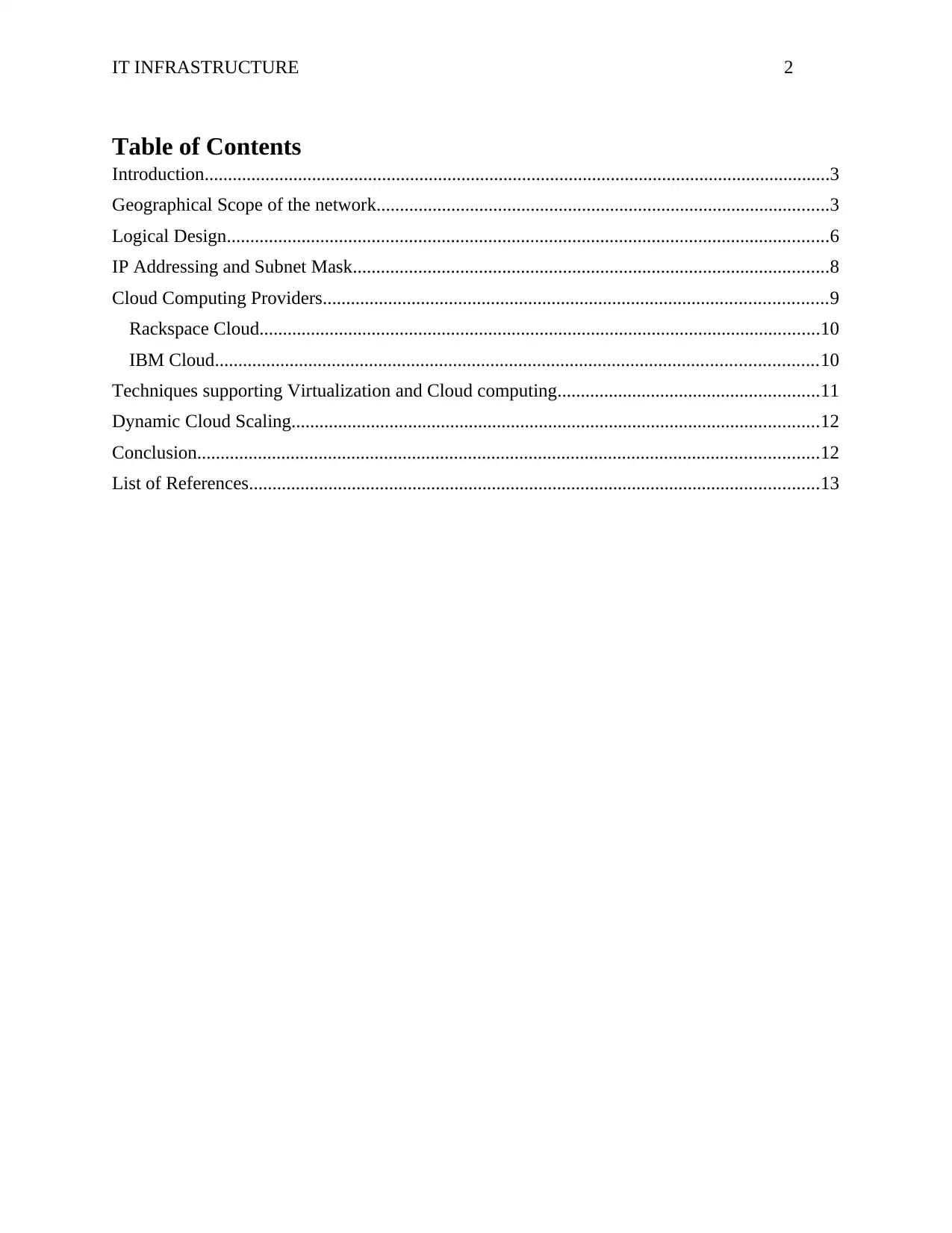
IT INFRASTRUCTURE 2
Table of Contents
Introduction......................................................................................................................................3
Geographical Scope of the network.................................................................................................3
Logical Design.................................................................................................................................6
IP Addressing and Subnet Mask......................................................................................................8
Cloud Computing Providers............................................................................................................9
Rackspace Cloud........................................................................................................................10
IBM Cloud.................................................................................................................................10
Techniques supporting Virtualization and Cloud computing........................................................11
Dynamic Cloud Scaling.................................................................................................................12
Conclusion.....................................................................................................................................12
List of References..........................................................................................................................13
Table of Contents
Introduction......................................................................................................................................3
Geographical Scope of the network.................................................................................................3
Logical Design.................................................................................................................................6
IP Addressing and Subnet Mask......................................................................................................8
Cloud Computing Providers............................................................................................................9
Rackspace Cloud........................................................................................................................10
IBM Cloud.................................................................................................................................10
Techniques supporting Virtualization and Cloud computing........................................................11
Dynamic Cloud Scaling.................................................................................................................12
Conclusion.....................................................................................................................................12
List of References..........................................................................................................................13
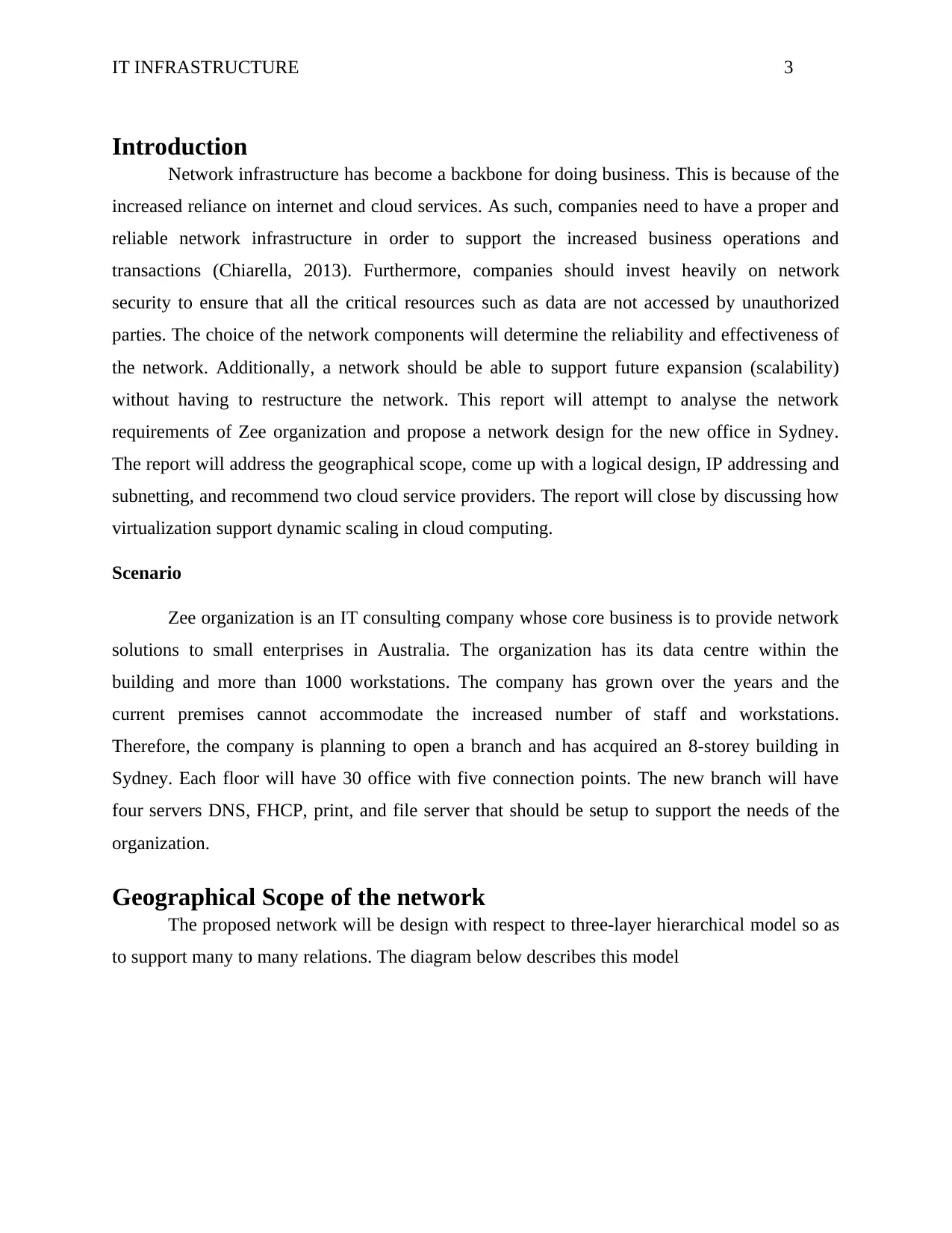
IT INFRASTRUCTURE 3
Introduction
Network infrastructure has become a backbone for doing business. This is because of the
increased reliance on internet and cloud services. As such, companies need to have a proper and
reliable network infrastructure in order to support the increased business operations and
transactions (Chiarella, 2013). Furthermore, companies should invest heavily on network
security to ensure that all the critical resources such as data are not accessed by unauthorized
parties. The choice of the network components will determine the reliability and effectiveness of
the network. Additionally, a network should be able to support future expansion (scalability)
without having to restructure the network. This report will attempt to analyse the network
requirements of Zee organization and propose a network design for the new office in Sydney.
The report will address the geographical scope, come up with a logical design, IP addressing and
subnetting, and recommend two cloud service providers. The report will close by discussing how
virtualization support dynamic scaling in cloud computing.
Scenario
Zee organization is an IT consulting company whose core business is to provide network
solutions to small enterprises in Australia. The organization has its data centre within the
building and more than 1000 workstations. The company has grown over the years and the
current premises cannot accommodate the increased number of staff and workstations.
Therefore, the company is planning to open a branch and has acquired an 8-storey building in
Sydney. Each floor will have 30 office with five connection points. The new branch will have
four servers DNS, FHCP, print, and file server that should be setup to support the needs of the
organization.
Geographical Scope of the network
The proposed network will be design with respect to three-layer hierarchical model so as
to support many to many relations. The diagram below describes this model
Introduction
Network infrastructure has become a backbone for doing business. This is because of the
increased reliance on internet and cloud services. As such, companies need to have a proper and
reliable network infrastructure in order to support the increased business operations and
transactions (Chiarella, 2013). Furthermore, companies should invest heavily on network
security to ensure that all the critical resources such as data are not accessed by unauthorized
parties. The choice of the network components will determine the reliability and effectiveness of
the network. Additionally, a network should be able to support future expansion (scalability)
without having to restructure the network. This report will attempt to analyse the network
requirements of Zee organization and propose a network design for the new office in Sydney.
The report will address the geographical scope, come up with a logical design, IP addressing and
subnetting, and recommend two cloud service providers. The report will close by discussing how
virtualization support dynamic scaling in cloud computing.
Scenario
Zee organization is an IT consulting company whose core business is to provide network
solutions to small enterprises in Australia. The organization has its data centre within the
building and more than 1000 workstations. The company has grown over the years and the
current premises cannot accommodate the increased number of staff and workstations.
Therefore, the company is planning to open a branch and has acquired an 8-storey building in
Sydney. Each floor will have 30 office with five connection points. The new branch will have
four servers DNS, FHCP, print, and file server that should be setup to support the needs of the
organization.
Geographical Scope of the network
The proposed network will be design with respect to three-layer hierarchical model so as
to support many to many relations. The diagram below describes this model
⊘ This is a preview!⊘
Do you want full access?
Subscribe today to unlock all pages.

Trusted by 1+ million students worldwide
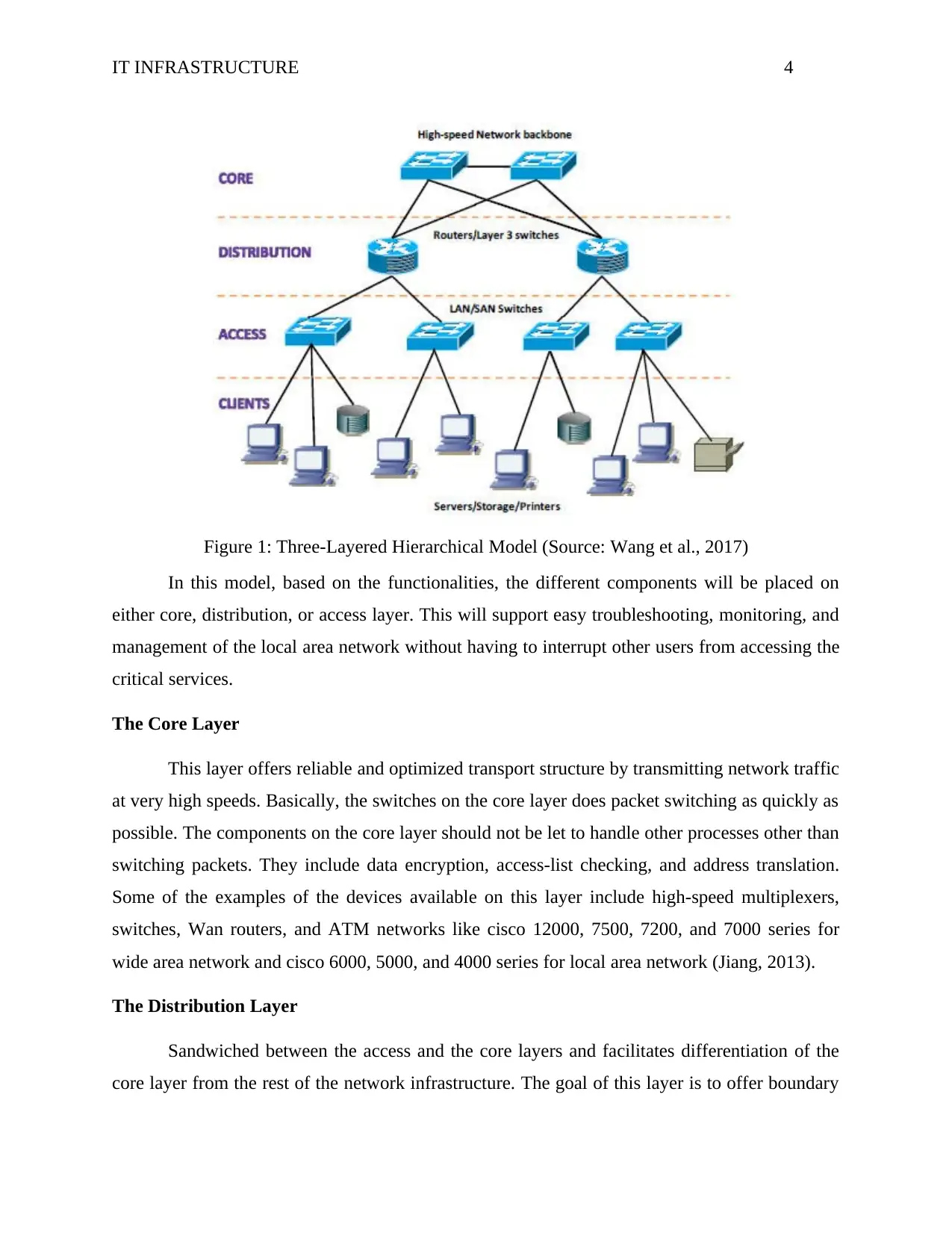
IT INFRASTRUCTURE 4
Figure 1: Three-Layered Hierarchical Model (Source: Wang et al., 2017)
In this model, based on the functionalities, the different components will be placed on
either core, distribution, or access layer. This will support easy troubleshooting, monitoring, and
management of the local area network without having to interrupt other users from accessing the
critical services.
The Core Layer
This layer offers reliable and optimized transport structure by transmitting network traffic
at very high speeds. Basically, the switches on the core layer does packet switching as quickly as
possible. The components on the core layer should not be let to handle other processes other than
switching packets. They include data encryption, access-list checking, and address translation.
Some of the examples of the devices available on this layer include high-speed multiplexers,
switches, Wan routers, and ATM networks like cisco 12000, 7500, 7200, and 7000 series for
wide area network and cisco 6000, 5000, and 4000 series for local area network (Jiang, 2013).
The Distribution Layer
Sandwiched between the access and the core layers and facilitates differentiation of the
core layer from the rest of the network infrastructure. The goal of this layer is to offer boundary
Figure 1: Three-Layered Hierarchical Model (Source: Wang et al., 2017)
In this model, based on the functionalities, the different components will be placed on
either core, distribution, or access layer. This will support easy troubleshooting, monitoring, and
management of the local area network without having to interrupt other users from accessing the
critical services.
The Core Layer
This layer offers reliable and optimized transport structure by transmitting network traffic
at very high speeds. Basically, the switches on the core layer does packet switching as quickly as
possible. The components on the core layer should not be let to handle other processes other than
switching packets. They include data encryption, access-list checking, and address translation.
Some of the examples of the devices available on this layer include high-speed multiplexers,
switches, Wan routers, and ATM networks like cisco 12000, 7500, 7200, and 7000 series for
wide area network and cisco 6000, 5000, and 4000 series for local area network (Jiang, 2013).
The Distribution Layer
Sandwiched between the access and the core layers and facilitates differentiation of the
core layer from the rest of the network infrastructure. The goal of this layer is to offer boundary
Paraphrase This Document
Need a fresh take? Get an instant paraphrase of this document with our AI Paraphraser
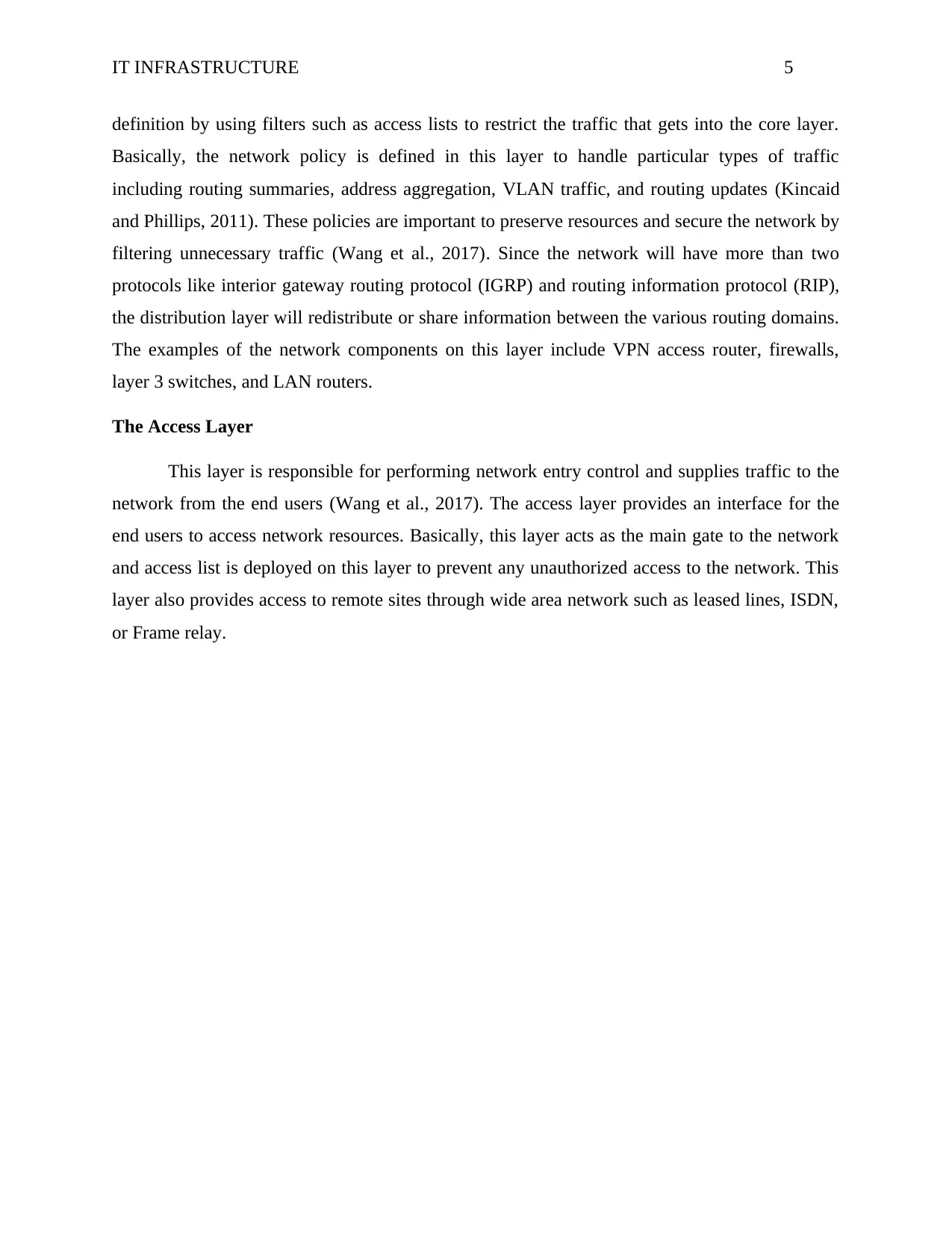
IT INFRASTRUCTURE 5
definition by using filters such as access lists to restrict the traffic that gets into the core layer.
Basically, the network policy is defined in this layer to handle particular types of traffic
including routing summaries, address aggregation, VLAN traffic, and routing updates (Kincaid
and Phillips, 2011). These policies are important to preserve resources and secure the network by
filtering unnecessary traffic (Wang et al., 2017). Since the network will have more than two
protocols like interior gateway routing protocol (IGRP) and routing information protocol (RIP),
the distribution layer will redistribute or share information between the various routing domains.
The examples of the network components on this layer include VPN access router, firewalls,
layer 3 switches, and LAN routers.
The Access Layer
This layer is responsible for performing network entry control and supplies traffic to the
network from the end users (Wang et al., 2017). The access layer provides an interface for the
end users to access network resources. Basically, this layer acts as the main gate to the network
and access list is deployed on this layer to prevent any unauthorized access to the network. This
layer also provides access to remote sites through wide area network such as leased lines, ISDN,
or Frame relay.
definition by using filters such as access lists to restrict the traffic that gets into the core layer.
Basically, the network policy is defined in this layer to handle particular types of traffic
including routing summaries, address aggregation, VLAN traffic, and routing updates (Kincaid
and Phillips, 2011). These policies are important to preserve resources and secure the network by
filtering unnecessary traffic (Wang et al., 2017). Since the network will have more than two
protocols like interior gateway routing protocol (IGRP) and routing information protocol (RIP),
the distribution layer will redistribute or share information between the various routing domains.
The examples of the network components on this layer include VPN access router, firewalls,
layer 3 switches, and LAN routers.
The Access Layer
This layer is responsible for performing network entry control and supplies traffic to the
network from the end users (Wang et al., 2017). The access layer provides an interface for the
end users to access network resources. Basically, this layer acts as the main gate to the network
and access list is deployed on this layer to prevent any unauthorized access to the network. This
layer also provides access to remote sites through wide area network such as leased lines, ISDN,
or Frame relay.
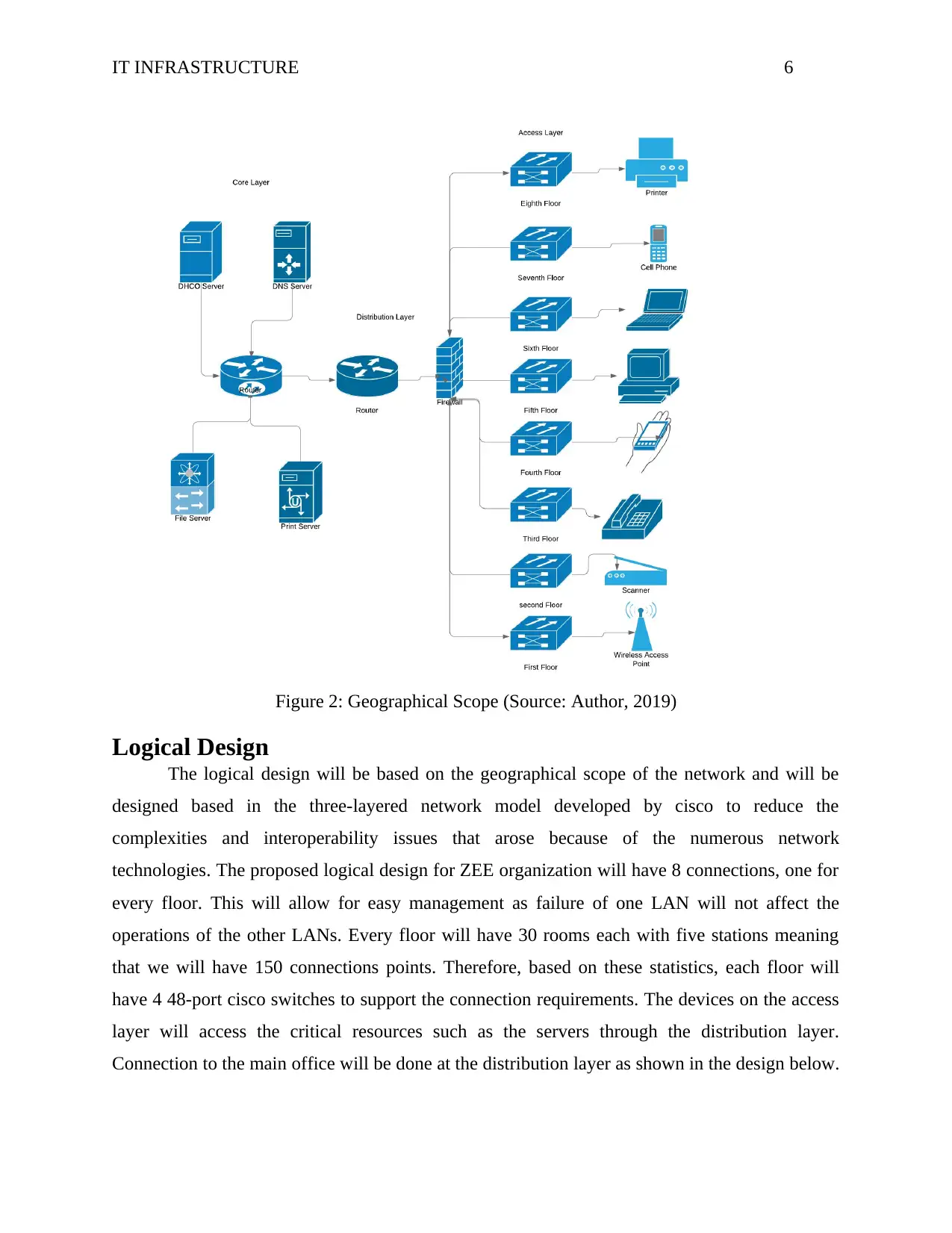
IT INFRASTRUCTURE 6
Figure 2: Geographical Scope (Source: Author, 2019)
Logical Design
The logical design will be based on the geographical scope of the network and will be
designed based in the three-layered network model developed by cisco to reduce the
complexities and interoperability issues that arose because of the numerous network
technologies. The proposed logical design for ZEE organization will have 8 connections, one for
every floor. This will allow for easy management as failure of one LAN will not affect the
operations of the other LANs. Every floor will have 30 rooms each with five stations meaning
that we will have 150 connections points. Therefore, based on these statistics, each floor will
have 4 48-port cisco switches to support the connection requirements. The devices on the access
layer will access the critical resources such as the servers through the distribution layer.
Connection to the main office will be done at the distribution layer as shown in the design below.
Figure 2: Geographical Scope (Source: Author, 2019)
Logical Design
The logical design will be based on the geographical scope of the network and will be
designed based in the three-layered network model developed by cisco to reduce the
complexities and interoperability issues that arose because of the numerous network
technologies. The proposed logical design for ZEE organization will have 8 connections, one for
every floor. This will allow for easy management as failure of one LAN will not affect the
operations of the other LANs. Every floor will have 30 rooms each with five stations meaning
that we will have 150 connections points. Therefore, based on these statistics, each floor will
have 4 48-port cisco switches to support the connection requirements. The devices on the access
layer will access the critical resources such as the servers through the distribution layer.
Connection to the main office will be done at the distribution layer as shown in the design below.
⊘ This is a preview!⊘
Do you want full access?
Subscribe today to unlock all pages.

Trusted by 1+ million students worldwide
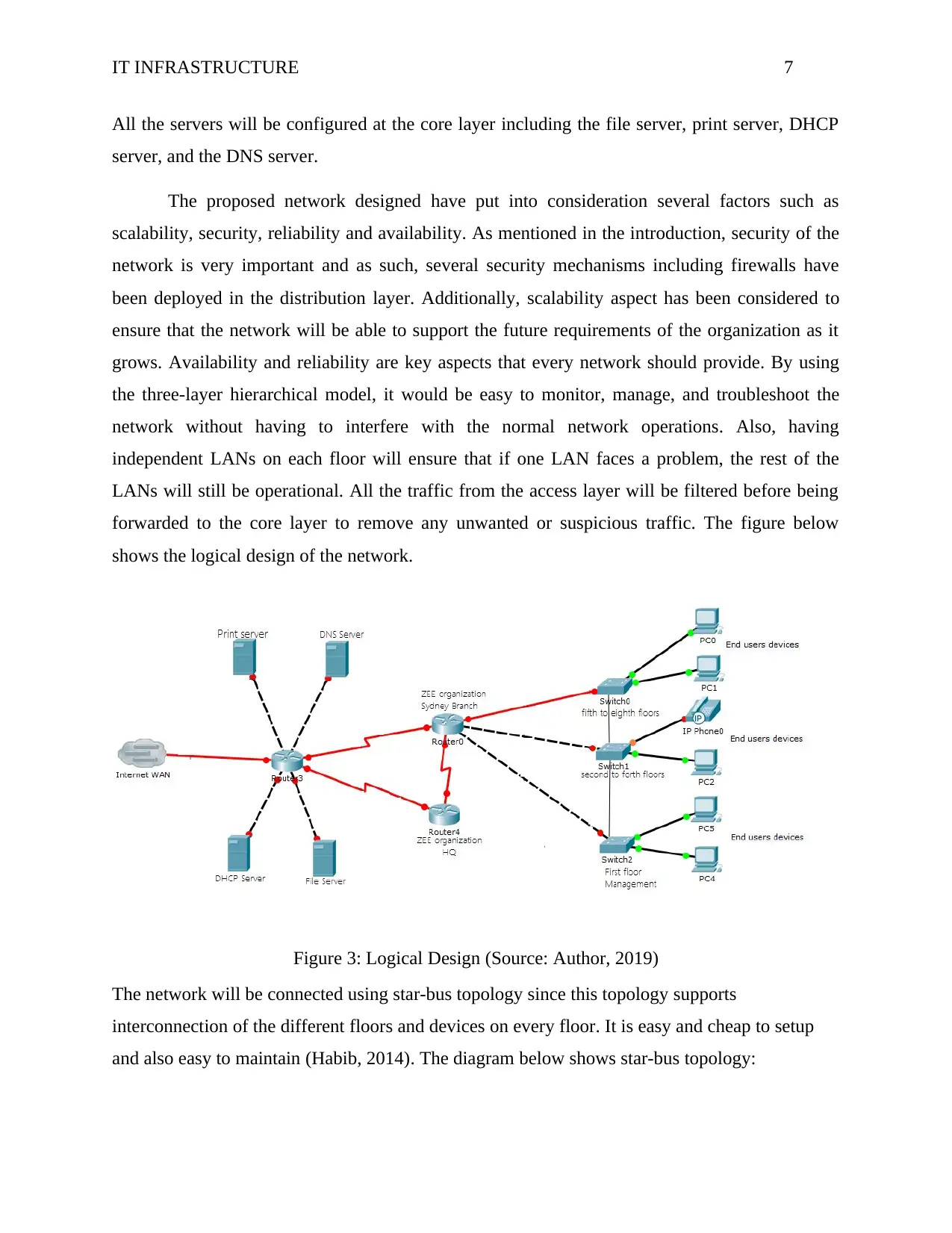
IT INFRASTRUCTURE 7
All the servers will be configured at the core layer including the file server, print server, DHCP
server, and the DNS server.
The proposed network designed have put into consideration several factors such as
scalability, security, reliability and availability. As mentioned in the introduction, security of the
network is very important and as such, several security mechanisms including firewalls have
been deployed in the distribution layer. Additionally, scalability aspect has been considered to
ensure that the network will be able to support the future requirements of the organization as it
grows. Availability and reliability are key aspects that every network should provide. By using
the three-layer hierarchical model, it would be easy to monitor, manage, and troubleshoot the
network without having to interfere with the normal network operations. Also, having
independent LANs on each floor will ensure that if one LAN faces a problem, the rest of the
LANs will still be operational. All the traffic from the access layer will be filtered before being
forwarded to the core layer to remove any unwanted or suspicious traffic. The figure below
shows the logical design of the network.
Figure 3: Logical Design (Source: Author, 2019)
The network will be connected using star-bus topology since this topology supports
interconnection of the different floors and devices on every floor. It is easy and cheap to setup
and also easy to maintain (Habib, 2014). The diagram below shows star-bus topology:
All the servers will be configured at the core layer including the file server, print server, DHCP
server, and the DNS server.
The proposed network designed have put into consideration several factors such as
scalability, security, reliability and availability. As mentioned in the introduction, security of the
network is very important and as such, several security mechanisms including firewalls have
been deployed in the distribution layer. Additionally, scalability aspect has been considered to
ensure that the network will be able to support the future requirements of the organization as it
grows. Availability and reliability are key aspects that every network should provide. By using
the three-layer hierarchical model, it would be easy to monitor, manage, and troubleshoot the
network without having to interfere with the normal network operations. Also, having
independent LANs on each floor will ensure that if one LAN faces a problem, the rest of the
LANs will still be operational. All the traffic from the access layer will be filtered before being
forwarded to the core layer to remove any unwanted or suspicious traffic. The figure below
shows the logical design of the network.
Figure 3: Logical Design (Source: Author, 2019)
The network will be connected using star-bus topology since this topology supports
interconnection of the different floors and devices on every floor. It is easy and cheap to setup
and also easy to maintain (Habib, 2014). The diagram below shows star-bus topology:
Paraphrase This Document
Need a fresh take? Get an instant paraphrase of this document with our AI Paraphraser
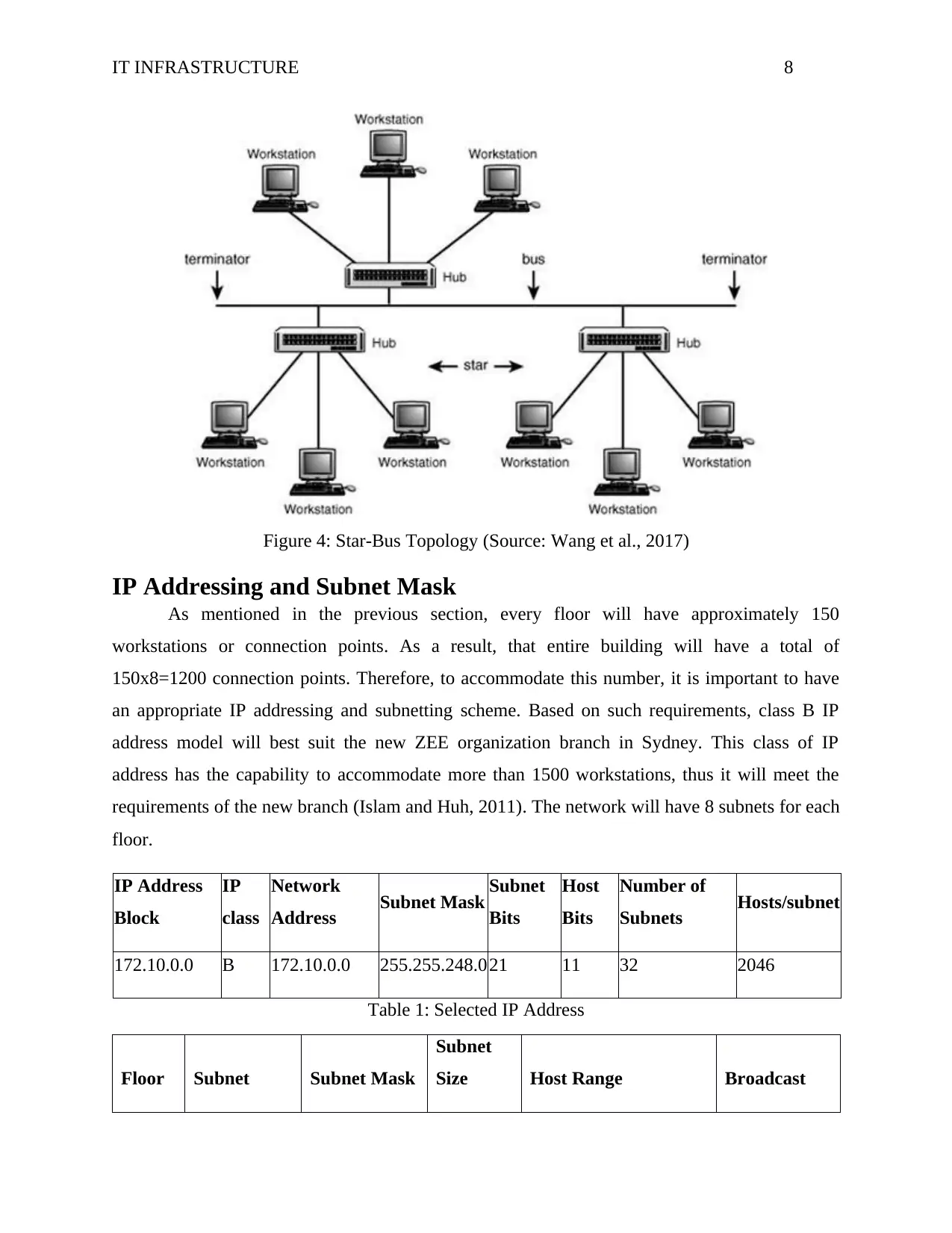
IT INFRASTRUCTURE 8
Figure 4: Star-Bus Topology (Source: Wang et al., 2017)
IP Addressing and Subnet Mask
As mentioned in the previous section, every floor will have approximately 150
workstations or connection points. As a result, that entire building will have a total of
150x8=1200 connection points. Therefore, to accommodate this number, it is important to have
an appropriate IP addressing and subnetting scheme. Based on such requirements, class B IP
address model will best suit the new ZEE organization branch in Sydney. This class of IP
address has the capability to accommodate more than 1500 workstations, thus it will meet the
requirements of the new branch (Islam and Huh, 2011). The network will have 8 subnets for each
floor.
IP Address
Block
IP
class
Network
Address Subnet Mask Subnet
Bits
Host
Bits
Number of
Subnets Hosts/subnet
172.10.0.0 B 172.10.0.0 255.255.248.0 21 11 32 2046
Table 1: Selected IP Address
Floor Subnet Subnet Mask
Subnet
Size Host Range Broadcast
Figure 4: Star-Bus Topology (Source: Wang et al., 2017)
IP Addressing and Subnet Mask
As mentioned in the previous section, every floor will have approximately 150
workstations or connection points. As a result, that entire building will have a total of
150x8=1200 connection points. Therefore, to accommodate this number, it is important to have
an appropriate IP addressing and subnetting scheme. Based on such requirements, class B IP
address model will best suit the new ZEE organization branch in Sydney. This class of IP
address has the capability to accommodate more than 1500 workstations, thus it will meet the
requirements of the new branch (Islam and Huh, 2011). The network will have 8 subnets for each
floor.
IP Address
Block
IP
class
Network
Address Subnet Mask Subnet
Bits
Host
Bits
Number of
Subnets Hosts/subnet
172.10.0.0 B 172.10.0.0 255.255.248.0 21 11 32 2046
Table 1: Selected IP Address
Floor Subnet Subnet Mask
Subnet
Size Host Range Broadcast
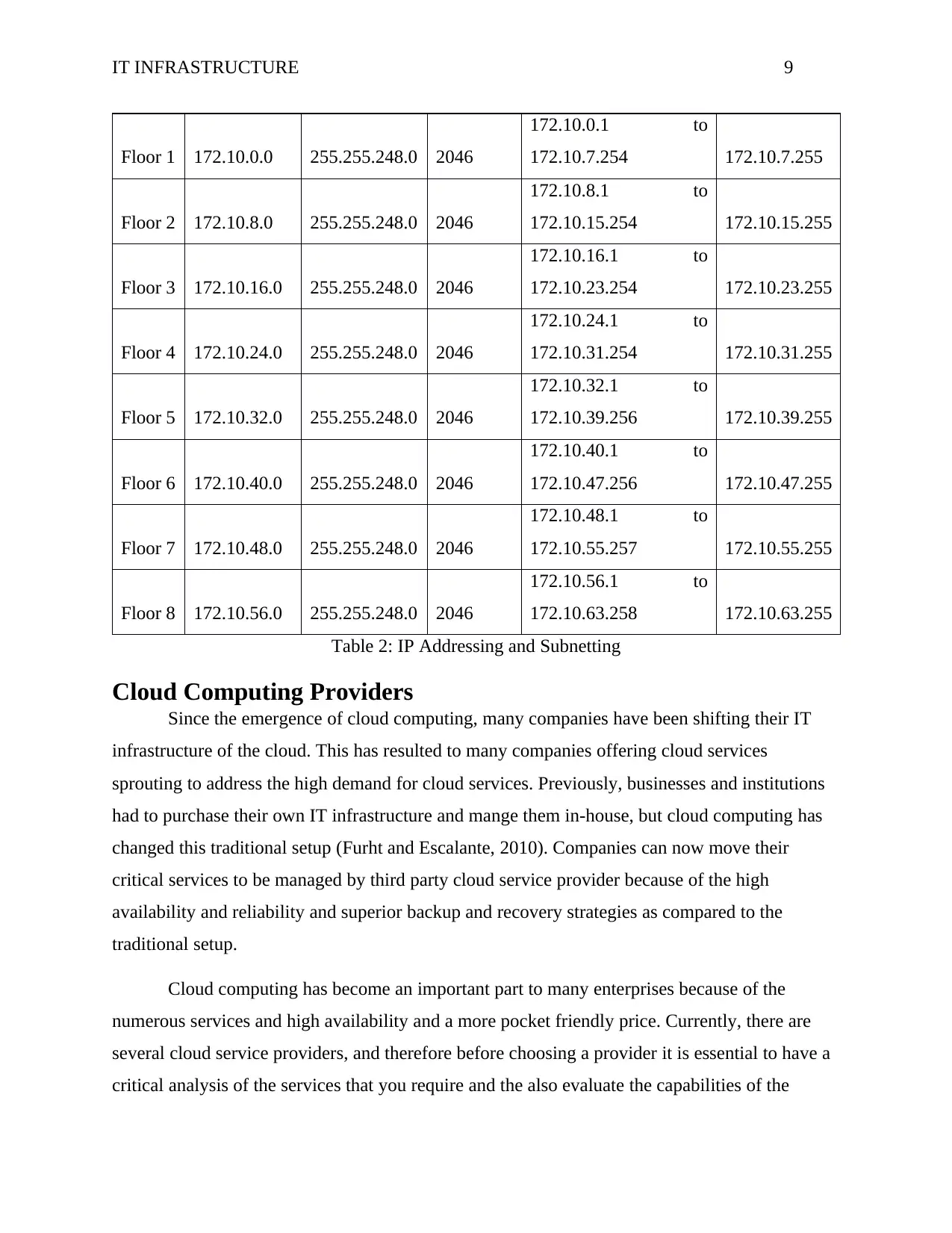
IT INFRASTRUCTURE 9
Floor 1 172.10.0.0 255.255.248.0 2046
172.10.0.1 to
172.10.7.254 172.10.7.255
Floor 2 172.10.8.0 255.255.248.0 2046
172.10.8.1 to
172.10.15.254 172.10.15.255
Floor 3 172.10.16.0 255.255.248.0 2046
172.10.16.1 to
172.10.23.254 172.10.23.255
Floor 4 172.10.24.0 255.255.248.0 2046
172.10.24.1 to
172.10.31.254 172.10.31.255
Floor 5 172.10.32.0 255.255.248.0 2046
172.10.32.1 to
172.10.39.256 172.10.39.255
Floor 6 172.10.40.0 255.255.248.0 2046
172.10.40.1 to
172.10.47.256 172.10.47.255
Floor 7 172.10.48.0 255.255.248.0 2046
172.10.48.1 to
172.10.55.257 172.10.55.255
Floor 8 172.10.56.0 255.255.248.0 2046
172.10.56.1 to
172.10.63.258 172.10.63.255
Table 2: IP Addressing and Subnetting
Cloud Computing Providers
Since the emergence of cloud computing, many companies have been shifting their IT
infrastructure of the cloud. This has resulted to many companies offering cloud services
sprouting to address the high demand for cloud services. Previously, businesses and institutions
had to purchase their own IT infrastructure and mange them in-house, but cloud computing has
changed this traditional setup (Furht and Escalante, 2010). Companies can now move their
critical services to be managed by third party cloud service provider because of the high
availability and reliability and superior backup and recovery strategies as compared to the
traditional setup.
Cloud computing has become an important part to many enterprises because of the
numerous services and high availability and a more pocket friendly price. Currently, there are
several cloud service providers, and therefore before choosing a provider it is essential to have a
critical analysis of the services that you require and the also evaluate the capabilities of the
Floor 1 172.10.0.0 255.255.248.0 2046
172.10.0.1 to
172.10.7.254 172.10.7.255
Floor 2 172.10.8.0 255.255.248.0 2046
172.10.8.1 to
172.10.15.254 172.10.15.255
Floor 3 172.10.16.0 255.255.248.0 2046
172.10.16.1 to
172.10.23.254 172.10.23.255
Floor 4 172.10.24.0 255.255.248.0 2046
172.10.24.1 to
172.10.31.254 172.10.31.255
Floor 5 172.10.32.0 255.255.248.0 2046
172.10.32.1 to
172.10.39.256 172.10.39.255
Floor 6 172.10.40.0 255.255.248.0 2046
172.10.40.1 to
172.10.47.256 172.10.47.255
Floor 7 172.10.48.0 255.255.248.0 2046
172.10.48.1 to
172.10.55.257 172.10.55.255
Floor 8 172.10.56.0 255.255.248.0 2046
172.10.56.1 to
172.10.63.258 172.10.63.255
Table 2: IP Addressing and Subnetting
Cloud Computing Providers
Since the emergence of cloud computing, many companies have been shifting their IT
infrastructure of the cloud. This has resulted to many companies offering cloud services
sprouting to address the high demand for cloud services. Previously, businesses and institutions
had to purchase their own IT infrastructure and mange them in-house, but cloud computing has
changed this traditional setup (Furht and Escalante, 2010). Companies can now move their
critical services to be managed by third party cloud service provider because of the high
availability and reliability and superior backup and recovery strategies as compared to the
traditional setup.
Cloud computing has become an important part to many enterprises because of the
numerous services and high availability and a more pocket friendly price. Currently, there are
several cloud service providers, and therefore before choosing a provider it is essential to have a
critical analysis of the services that you require and the also evaluate the capabilities of the
⊘ This is a preview!⊘
Do you want full access?
Subscribe today to unlock all pages.

Trusted by 1+ million students worldwide
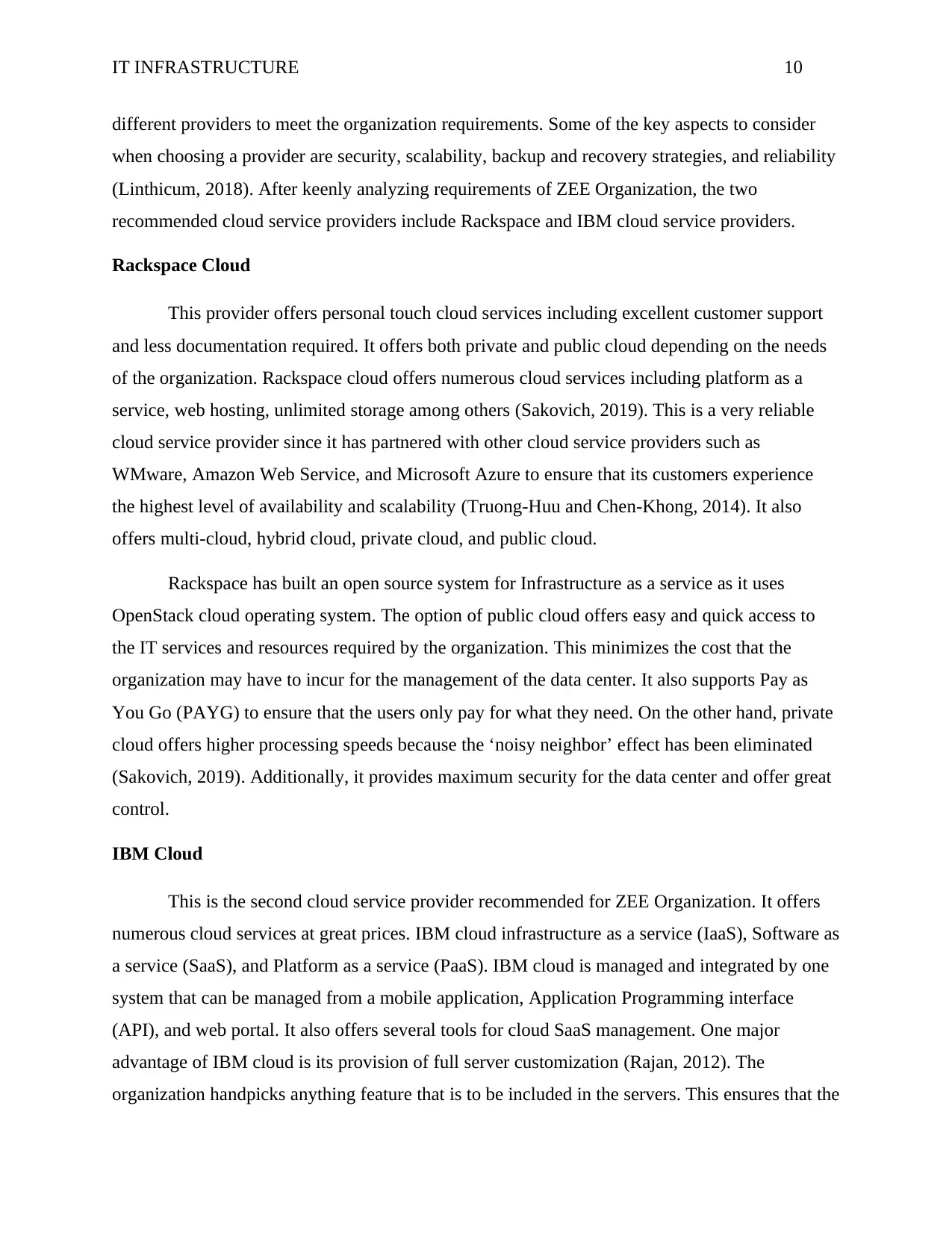
IT INFRASTRUCTURE 10
different providers to meet the organization requirements. Some of the key aspects to consider
when choosing a provider are security, scalability, backup and recovery strategies, and reliability
(Linthicum, 2018). After keenly analyzing requirements of ZEE Organization, the two
recommended cloud service providers include Rackspace and IBM cloud service providers.
Rackspace Cloud
This provider offers personal touch cloud services including excellent customer support
and less documentation required. It offers both private and public cloud depending on the needs
of the organization. Rackspace cloud offers numerous cloud services including platform as a
service, web hosting, unlimited storage among others (Sakovich, 2019). This is a very reliable
cloud service provider since it has partnered with other cloud service providers such as
WMware, Amazon Web Service, and Microsoft Azure to ensure that its customers experience
the highest level of availability and scalability (Truong-Huu and Chen-Khong, 2014). It also
offers multi-cloud, hybrid cloud, private cloud, and public cloud.
Rackspace has built an open source system for Infrastructure as a service as it uses
OpenStack cloud operating system. The option of public cloud offers easy and quick access to
the IT services and resources required by the organization. This minimizes the cost that the
organization may have to incur for the management of the data center. It also supports Pay as
You Go (PAYG) to ensure that the users only pay for what they need. On the other hand, private
cloud offers higher processing speeds because the ‘noisy neighbor’ effect has been eliminated
(Sakovich, 2019). Additionally, it provides maximum security for the data center and offer great
control.
IBM Cloud
This is the second cloud service provider recommended for ZEE Organization. It offers
numerous cloud services at great prices. IBM cloud infrastructure as a service (IaaS), Software as
a service (SaaS), and Platform as a service (PaaS). IBM cloud is managed and integrated by one
system that can be managed from a mobile application, Application Programming interface
(API), and web portal. It also offers several tools for cloud SaaS management. One major
advantage of IBM cloud is its provision of full server customization (Rajan, 2012). The
organization handpicks anything feature that is to be included in the servers. This ensures that the
different providers to meet the organization requirements. Some of the key aspects to consider
when choosing a provider are security, scalability, backup and recovery strategies, and reliability
(Linthicum, 2018). After keenly analyzing requirements of ZEE Organization, the two
recommended cloud service providers include Rackspace and IBM cloud service providers.
Rackspace Cloud
This provider offers personal touch cloud services including excellent customer support
and less documentation required. It offers both private and public cloud depending on the needs
of the organization. Rackspace cloud offers numerous cloud services including platform as a
service, web hosting, unlimited storage among others (Sakovich, 2019). This is a very reliable
cloud service provider since it has partnered with other cloud service providers such as
WMware, Amazon Web Service, and Microsoft Azure to ensure that its customers experience
the highest level of availability and scalability (Truong-Huu and Chen-Khong, 2014). It also
offers multi-cloud, hybrid cloud, private cloud, and public cloud.
Rackspace has built an open source system for Infrastructure as a service as it uses
OpenStack cloud operating system. The option of public cloud offers easy and quick access to
the IT services and resources required by the organization. This minimizes the cost that the
organization may have to incur for the management of the data center. It also supports Pay as
You Go (PAYG) to ensure that the users only pay for what they need. On the other hand, private
cloud offers higher processing speeds because the ‘noisy neighbor’ effect has been eliminated
(Sakovich, 2019). Additionally, it provides maximum security for the data center and offer great
control.
IBM Cloud
This is the second cloud service provider recommended for ZEE Organization. It offers
numerous cloud services at great prices. IBM cloud infrastructure as a service (IaaS), Software as
a service (SaaS), and Platform as a service (PaaS). IBM cloud is managed and integrated by one
system that can be managed from a mobile application, Application Programming interface
(API), and web portal. It also offers several tools for cloud SaaS management. One major
advantage of IBM cloud is its provision of full server customization (Rajan, 2012). The
organization handpicks anything feature that is to be included in the servers. This ensures that the
Paraphrase This Document
Need a fresh take? Get an instant paraphrase of this document with our AI Paraphraser
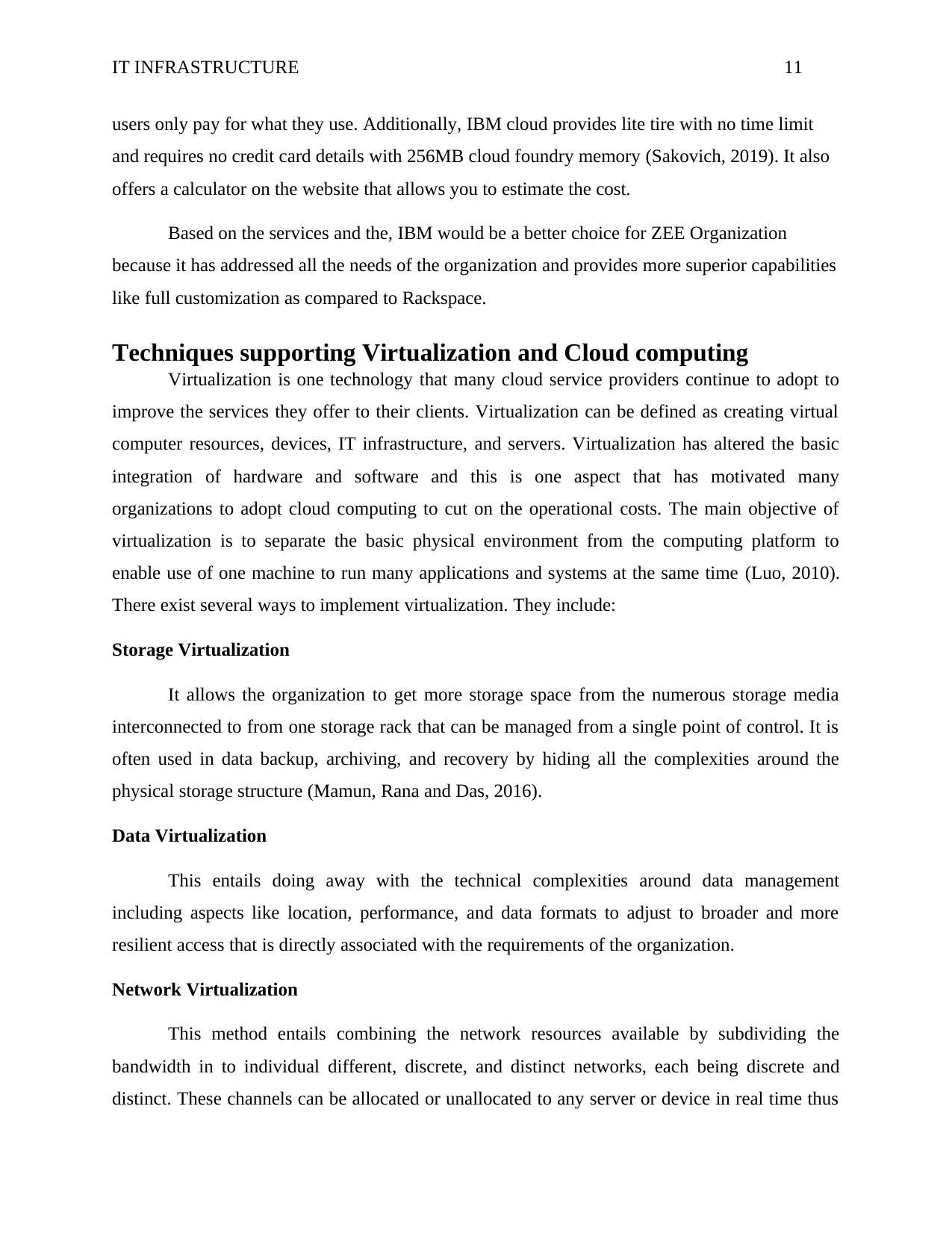
IT INFRASTRUCTURE 11
users only pay for what they use. Additionally, IBM cloud provides lite tire with no time limit
and requires no credit card details with 256MB cloud foundry memory (Sakovich, 2019). It also
offers a calculator on the website that allows you to estimate the cost.
Based on the services and the, IBM would be a better choice for ZEE Organization
because it has addressed all the needs of the organization and provides more superior capabilities
like full customization as compared to Rackspace.
Techniques supporting Virtualization and Cloud computing
Virtualization is one technology that many cloud service providers continue to adopt to
improve the services they offer to their clients. Virtualization can be defined as creating virtual
computer resources, devices, IT infrastructure, and servers. Virtualization has altered the basic
integration of hardware and software and this is one aspect that has motivated many
organizations to adopt cloud computing to cut on the operational costs. The main objective of
virtualization is to separate the basic physical environment from the computing platform to
enable use of one machine to run many applications and systems at the same time (Luo, 2010).
There exist several ways to implement virtualization. They include:
Storage Virtualization
It allows the organization to get more storage space from the numerous storage media
interconnected to from one storage rack that can be managed from a single point of control. It is
often used in data backup, archiving, and recovery by hiding all the complexities around the
physical storage structure (Mamun, Rana and Das, 2016).
Data Virtualization
This entails doing away with the technical complexities around data management
including aspects like location, performance, and data formats to adjust to broader and more
resilient access that is directly associated with the requirements of the organization.
Network Virtualization
This method entails combining the network resources available by subdividing the
bandwidth in to individual different, discrete, and distinct networks, each being discrete and
distinct. These channels can be allocated or unallocated to any server or device in real time thus
users only pay for what they use. Additionally, IBM cloud provides lite tire with no time limit
and requires no credit card details with 256MB cloud foundry memory (Sakovich, 2019). It also
offers a calculator on the website that allows you to estimate the cost.
Based on the services and the, IBM would be a better choice for ZEE Organization
because it has addressed all the needs of the organization and provides more superior capabilities
like full customization as compared to Rackspace.
Techniques supporting Virtualization and Cloud computing
Virtualization is one technology that many cloud service providers continue to adopt to
improve the services they offer to their clients. Virtualization can be defined as creating virtual
computer resources, devices, IT infrastructure, and servers. Virtualization has altered the basic
integration of hardware and software and this is one aspect that has motivated many
organizations to adopt cloud computing to cut on the operational costs. The main objective of
virtualization is to separate the basic physical environment from the computing platform to
enable use of one machine to run many applications and systems at the same time (Luo, 2010).
There exist several ways to implement virtualization. They include:
Storage Virtualization
It allows the organization to get more storage space from the numerous storage media
interconnected to from one storage rack that can be managed from a single point of control. It is
often used in data backup, archiving, and recovery by hiding all the complexities around the
physical storage structure (Mamun, Rana and Das, 2016).
Data Virtualization
This entails doing away with the technical complexities around data management
including aspects like location, performance, and data formats to adjust to broader and more
resilient access that is directly associated with the requirements of the organization.
Network Virtualization
This method entails combining the network resources available by subdividing the
bandwidth in to individual different, discrete, and distinct networks, each being discrete and
distinct. These channels can be allocated or unallocated to any server or device in real time thus
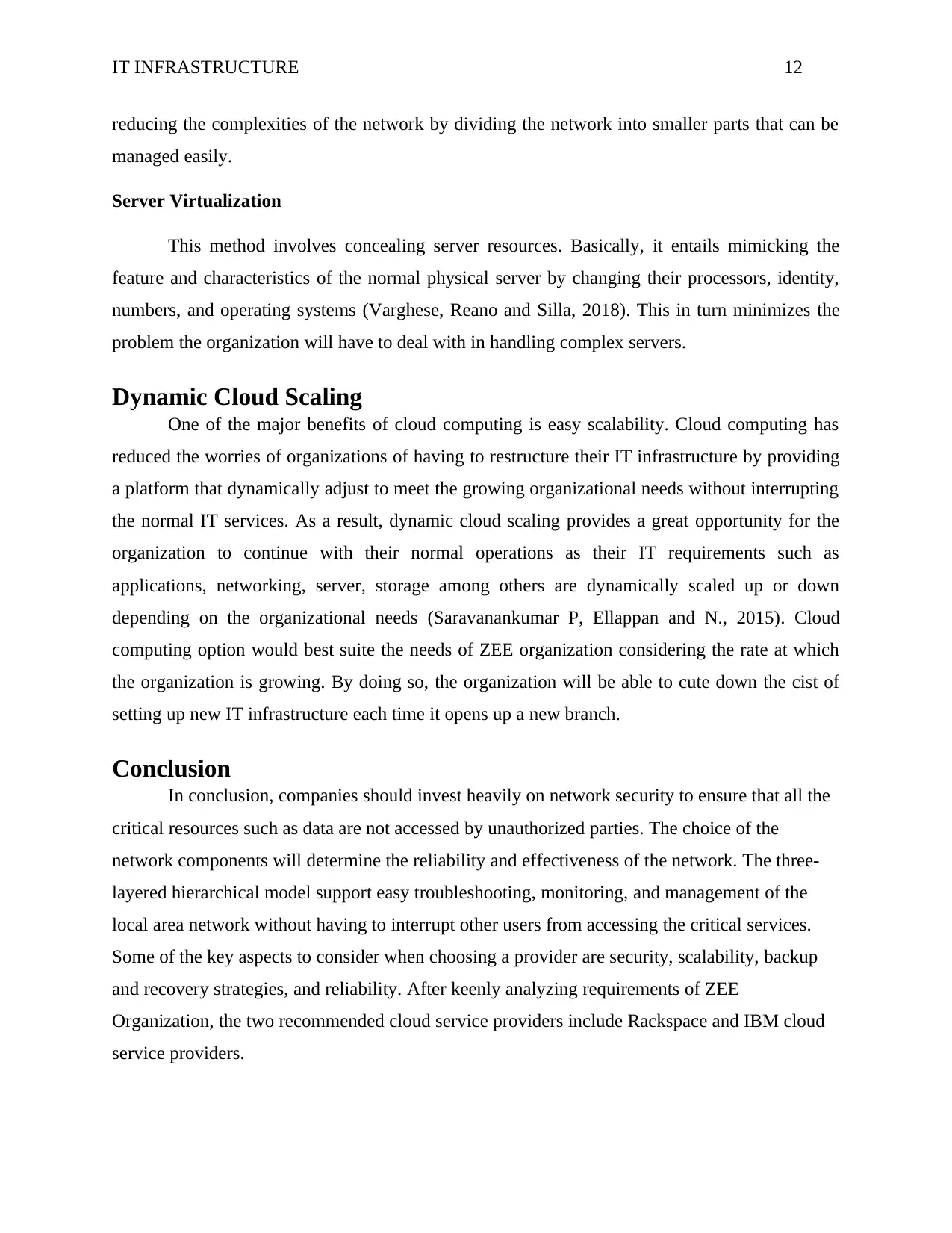
IT INFRASTRUCTURE 12
reducing the complexities of the network by dividing the network into smaller parts that can be
managed easily.
Server Virtualization
This method involves concealing server resources. Basically, it entails mimicking the
feature and characteristics of the normal physical server by changing their processors, identity,
numbers, and operating systems (Varghese, Reano and Silla, 2018). This in turn minimizes the
problem the organization will have to deal with in handling complex servers.
Dynamic Cloud Scaling
One of the major benefits of cloud computing is easy scalability. Cloud computing has
reduced the worries of organizations of having to restructure their IT infrastructure by providing
a platform that dynamically adjust to meet the growing organizational needs without interrupting
the normal IT services. As a result, dynamic cloud scaling provides a great opportunity for the
organization to continue with their normal operations as their IT requirements such as
applications, networking, server, storage among others are dynamically scaled up or down
depending on the organizational needs (Saravanankumar P, Ellappan and N., 2015). Cloud
computing option would best suite the needs of ZEE organization considering the rate at which
the organization is growing. By doing so, the organization will be able to cute down the cist of
setting up new IT infrastructure each time it opens up a new branch.
Conclusion
In conclusion, companies should invest heavily on network security to ensure that all the
critical resources such as data are not accessed by unauthorized parties. The choice of the
network components will determine the reliability and effectiveness of the network. The three-
layered hierarchical model support easy troubleshooting, monitoring, and management of the
local area network without having to interrupt other users from accessing the critical services.
Some of the key aspects to consider when choosing a provider are security, scalability, backup
and recovery strategies, and reliability. After keenly analyzing requirements of ZEE
Organization, the two recommended cloud service providers include Rackspace and IBM cloud
service providers.
reducing the complexities of the network by dividing the network into smaller parts that can be
managed easily.
Server Virtualization
This method involves concealing server resources. Basically, it entails mimicking the
feature and characteristics of the normal physical server by changing their processors, identity,
numbers, and operating systems (Varghese, Reano and Silla, 2018). This in turn minimizes the
problem the organization will have to deal with in handling complex servers.
Dynamic Cloud Scaling
One of the major benefits of cloud computing is easy scalability. Cloud computing has
reduced the worries of organizations of having to restructure their IT infrastructure by providing
a platform that dynamically adjust to meet the growing organizational needs without interrupting
the normal IT services. As a result, dynamic cloud scaling provides a great opportunity for the
organization to continue with their normal operations as their IT requirements such as
applications, networking, server, storage among others are dynamically scaled up or down
depending on the organizational needs (Saravanankumar P, Ellappan and N., 2015). Cloud
computing option would best suite the needs of ZEE organization considering the rate at which
the organization is growing. By doing so, the organization will be able to cute down the cist of
setting up new IT infrastructure each time it opens up a new branch.
Conclusion
In conclusion, companies should invest heavily on network security to ensure that all the
critical resources such as data are not accessed by unauthorized parties. The choice of the
network components will determine the reliability and effectiveness of the network. The three-
layered hierarchical model support easy troubleshooting, monitoring, and management of the
local area network without having to interrupt other users from accessing the critical services.
Some of the key aspects to consider when choosing a provider are security, scalability, backup
and recovery strategies, and reliability. After keenly analyzing requirements of ZEE
Organization, the two recommended cloud service providers include Rackspace and IBM cloud
service providers.
⊘ This is a preview!⊘
Do you want full access?
Subscribe today to unlock all pages.

Trusted by 1+ million students worldwide
1 out of 14
Related Documents
Your All-in-One AI-Powered Toolkit for Academic Success.
+13062052269
info@desklib.com
Available 24*7 on WhatsApp / Email
![[object Object]](/_next/static/media/star-bottom.7253800d.svg)
Unlock your academic potential
Copyright © 2020–2025 A2Z Services. All Rights Reserved. Developed and managed by ZUCOL.





